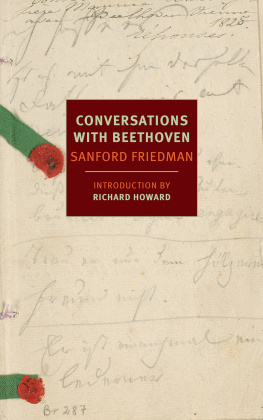Jerry eBooks
No copyright  2015 by Jerry eBooks
2015 by Jerry eBooks
No rights reserved. All parts of this book may be reproduced in any form and by any means for any purpose without any prior written consent of anyone.
A N ASTONISHING TALE OF ONE LOCK OF
HAIR AND ITS AMAZING TRAVELSFROM
NINETEENTH-CENTURY V IENNA TO TWENTY-
FIRST-CENTURY A MERICA.
Ludwig van Beethoven lay dying in 1827, a young musician named Ferdinand Hiller came to pay his respects to the great composer. In those days, it was customary to snip a lock of hair as a keepsake, and this Hiller did a day after Beethovens death. By the time he was buried, Beethovens head had been nearly shorn by the many people who similarly had wanted a lasting memento of the great man. Such was his powerful effect on all those who had heard his music.
For a century, the lock of hair was a treasured Hiller family relic, and perhaps was destined to end up sequestered in a bank vault, until it somehow found its way to the town of Gilleleje, in Nazi-occupied Denmark, during the darkest days of the Second World War. There, it was given to a local doctor, Kay Fremming, who was deeply involved in the effort to help save hundreds of hunted and frightened Jews. Who gave him the hair, and why? And what was the fate of those refugees, holed up in the attic of Gillelejes church?
After Fremmings death, his daughter assumed ownership of the lock, and eventually consigned it for sale at Sothebys, where two American Beethoven enthusiasts, Ira Brilliant and Che Guevara, purchased it in 1994. Subsequently, they and others instituted a series of complex forensic tests in the hope of finding the probable causes of the composer s chronically bad health, his deafness, and the final demise that Ferdinand Hiller had witnessed all those years ago. The results, revealed for the first time here, are startling, and are the most compelling explanation yet offered for why one of the foremost musicians the world has ever known was forced to spend much of his life in silence.
In Beethovens Hair, Russell Martin has created a rich historical treasure hunt, an Indiana Joneslike tale of false leads, amazing breakthroughs, and incredible revelations. This unique and fascinating book is a moving testament to the power of music, the lure of relics, the heroism of the Resistance movement, and the brilliance of molecular science.
R USSELL M ARTIN is the author of five works of nonfiction, including the highly acclaimed Out of Silence, and a novel. He lives in Colorado.
Copyright 2000 by Russell Martin.
All rights reserved. Printed in the United States of America. No part of this book may be reproduced or transmitted in any form or by any means, electronic or mechanical, including photocopying, recording, or by any information storage and retrieval system, without written permission from the publisher. For information, address Broadway Books, a division of Random House, Inc., 1540 Broadway, New York, NY 10036.
Broadway Books titles may be purchased for business or promotional use or for special sales. For information, please write to: Special Markets Department, Random House, Inc., 1540 Broadway, New York, NY 10036.
BROADWAY BOOKS and its logo, a letter B bisected on the diagonal, are trademarks of Broadway Books, a division of Random House, Inc.
Visit our Web site at www.broadwaybooks.com
FIRST EDITION
ISBN 0-7679-0350-1
00 01 02 03 04 10 9 8 7 6 5 4 3 2 1
KH
Alive again? then show me where he is:
Ill give a thousand pound to look upon him.
He hath no eyes, the dust hath blinded them.
Comb down his hair: look! look! it stands upright,
Like lime-twigs set to catch my winged soul.
WILLIAM SHAKESPEARE,
HENRY THE SIXTH, PART 2
Oh, it would be so lovely to live a thousand lives.
LUDWIG VAN BEETHOVEN,
IN A LETTER TO FRANZ
WEGELER
PRELUDE
B EETHOVENS HAIR, SHELTERED FOR NEARLY two centuries inside a glass locket, was about to become the subject of rapt attention on a warm December morning in 1995. The two men to whom it now belongedBrooklyn-born Ira Brilliant, a retired Phoenix real estate developer, and a Mexican-American physician whose surprising name is Che Guevarahad been joined by a coterie of inquisitors in a teaching theater at the University of Arizona Medical Center in Tucson: a forensic anthropologist was present; so was a medical examiner, an archivist and conservator, a medical photographer, a recording secretary, a notary public, a local television news team, plus a London-based film crew from the BBC. Everyone gathered promptly at 10:30 because there was much to do, and the first order of business was the signing of a contract that stipulated how the hair would be divided. Once counted, strand by aging and fragile strand, 27 percent would remain the property of Guevara, the principal investor, a urological surgeon from the border town of Nogales. The remainder would be donated by him and co-owner Brilliant to the Ira. F. Brilliant Center for Beethoven Studies at San Jose State University in California, where it would remain in perpetuity
Contract signed and the notarys seal correctly affixed, soon it was time to turn to the locket that held the hair. Housed in a dark-wood oval frame a bit more than ten centimeters long, the coil of fine brown and gray hair was sealed between two pieces of glass, one of which was convex. On the brittle paper that was sealed to the flat back of the frame, someone named Paul Hiller long ago had written the following words in German, then added his signature beneath them:
This hair was cut off Beethovens corpse by my father, Dr. Ferdinand v. Hiller on the day after Ludwig van Beethovens death, that is, on 27 March 1827, and was given to me as a birthday present in Cologne on May 1, 1883.
While Ira Brilliant and the others watched with fascination, Dr. Guevara and conservator Nancy Odegaardboth dressed in green surgical scrubs and wearing masks and glovesworked at a sterile table, measuring with calipers the glass and the frame that surrounded it, calling out a series of numbers as well as their impressions of the lockets condition before Guevara wielded a scalpel and prepared to go inside. This was surgery of a sort, and the doctor proceeded with careful confidence, describing each cut and every observation with the kind of commentary he might have made if the subject at hand had been a human gut and the gathered observers were surgical interns still prone to getting queasy. Now Im slicing through the last of the glue that holds the paper backing, he announced, his voice bearing more than a hint of his preoccupation. Ill pull the backing away now, and... lets see, below... heres another layer of paper, with writing on it, and... the writings in French, I believe. Can someone verify that this is in French and translate it for us?
A video camera designed for recording the intricacies and complexities of rather more conventional surgeries looked down from overhead and the rest of the group watched the doctors work on television monitors placed around the room, and yes, that was French, someone offered. The text was set in type, but was difficult to make sense of, and the rooms quick consensus was that the paper was simply newspaper scrap that had been used for backing. Yet the words written on the next layer Guevara exposed were both decipherable and surprising. Handwritten this time, and again in German, they explained that the locket was newly pasted by a picture framer in Cologne in 1911, the resealing done at a time when Paul Hiller would have been 58-years old, and presumably about the time when he wrote his explanatory note on the outer paper.














 2015 by Jerry eBooks
2015 by Jerry eBooks